Roman Aqueducts – The History of Ancient Roman Aqueducts
The ancient Roman aqueducts are regarded as incredible engineering feats. But, what is an aqueduct and what were aqueducts used for? Aqueducts in Rome significantly changed the way water was sourced and distributed in the ancient world. Today, we shall explore all the facts about Roman aqueducts, and answer related questions, such as “how do aqueducts work?”.
Exploring the Ancient Roman Aqueducts
Aqueducts were crucial in the development of regions that had inadequate access to fresh water sources. They have historically aided in keeping our drinking water free of contaminants, such as human waste, considerably improving public health in towns with rudimentary sewage systems. Although the Romans are typically regarded as the ancient world’s best aqueduct builders, qanāt systems were actually already in use centuries earlier in ancient India, Persia, Egypt, as well as other Middle Eastern nations.

These systems relied on tunnels dug through hillsides to transport water to irrigate the plains below. The intricate system that serviced the Roman Empire’s capital remains a great engineering marvel. The Aqueducts in Rome were built over 500 years to transport water to the great city from as far away as 92 kilometers. Some of those ancient Roman aqueducts are still used today! Water entered Rome just using the force of gravity and typically passed through a network of distribution tanks located within the city. The magnificent baths and fountains of Rome were supplied with constant water in this manner.
Water was not often stored, and any excess was utilized to flush the city’s drains to help the city’s sanitation.
Construction of Roman Aqueducts
In this section, we will look at the construction facts about Roman aqueducts. This includes the materials and various engineering techniques used to construct the aqueducts in Rome. We will also look at a few notable examples of ancient Roman aqueducts.

Materials
Although their uses are somewhat varied, Roman mortar, concrete, plaster, stucco, and even opus signinum were all comprised of the same basic materials. A filler (or aggregate), water, and a binding agent are the three basic ingredients. Rubble, gravel, broken pottery, stones, and sand could all be used as fillers. Water was vital to the mix, yet only small amounts were used at a time. As a binding agent, gypsum, lime, or volcanic material from the ancient Puteoli region near Naples was used.
These mixtures were sometimes enhanced with additional ingredients. Lime mortar, a combination of sand and slaked lime, was the most basic type of binding material.
Gypsum was also utilized when available. Later, beginning in Augustus’ era, pozzulana was added, which was mixed with lime to produce Roman concrete, also known as opus caementitium. This combination was therefore the basis for the concrete used between the bricks and stones of the walls of the aqueducts in Rome. It was also used to create the mortar that was added between the bricks and stones to strengthen the walls. It was also used to make the plaster and stucco that lined the walls. The opus signinum that could be made from the aggregate, binding agent, and water combination was also waterproof and proved particularly useful for plastering the aqueducts.

After the foundations were laid, two parallel brick or stone walls were created, and concrete was subsequently poured between these walls. Protruding boundary courses of huge bricks were used on certain levels of larger constructions for stability. Some brickmakers put stamps on their bricks throughout the manufacturing process, which could provide insight into the brick’s age and provenance. Whenever possible, local materials were utilized in the construction of the Roman aqueducts. Brick kilns and quarries have been discovered along several aqueducts in Rome to supply the materials for the building of the various channels, substructures, and bridges.
Engineering Techniques
Now that we have learned what materials were used in the construction of the aqueducts in Rome, we can explore the various engineering techniques that the Romans used. Engineers used arches, tunnels, and channels to transport fresh water for many miles so that Romans had a constant supply of fresh water.
Let’s explore each of these in more detail.
Arches
Arches were used in Roman aqueducts to sustain the weight of the water channel and enable it to traverse valleys or other geographical obstacles. These arches were built with a sequence of wedge-shaped stones (or voussoirs), that were stacked on top of each other and kept in place by the arch’s pressure. The keystone, which is the very last stone put at the highest point of the arch, holds all the other stones in place. Roman aqueduct arches were often segmented and semi-circular and could span considerable distances.
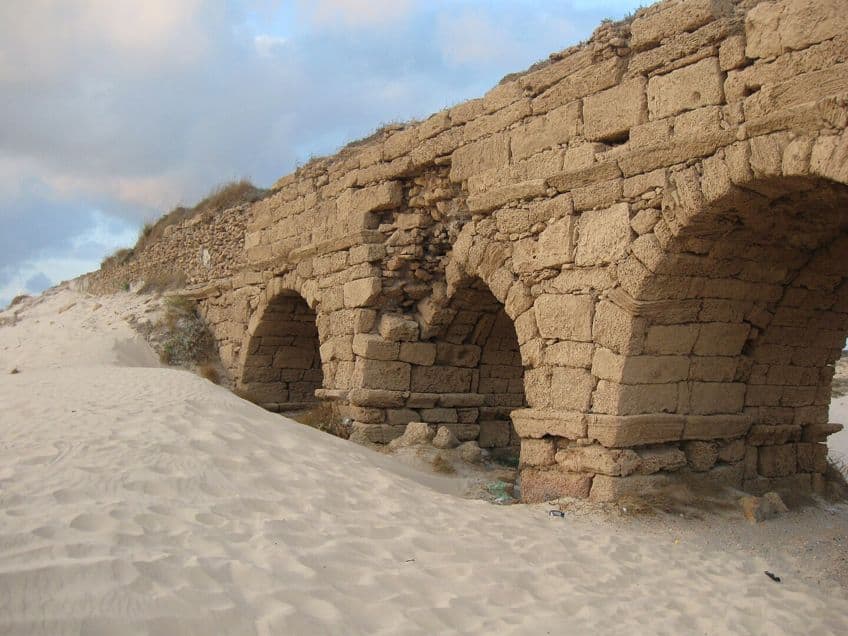
Tunnels
Tunneling through mountains or hills was more viable in certain circumstances than building arches above them. Tunnels were built by Roman engineers employing a process known as “cut and cover,” which required excavating a trench, constructing the walls and roof of the tunnel, and then covering it with earth. To avoid water leakage, the tunnels were coated with waterproof materials. The Romans often utilized the qanat method of tunnel building, which included digging many vertical shafts across a hilltop and connecting the bottoms of the shafts.
The longest Roman tunnel that has been discovered so far is the Mornant tunnel in the Gier aqueduct of Lyon in France, and is 825 meters in length!
Channels
The water channels used in Roman aqueducts were mainly composed of concrete or stone and were meticulously planned to ensure a smooth and steady water flow. To avoid leaking, the canals were typically coated with a waterproof substance such as cement. To guarantee consistent water flow, the channels were designed with a slight gradient that did not cause turbulence or eddies. To protect the water from debris or pollution, the channels were sometimes covered with tiles or stone slabs.

Examples of Notable Roman Aqueducts
Let’s now explore a few notable aqueducts in Rome, and discuss their unique characteristics. Among the most renowned aqueducts in Rome are the Aqua Claudia, Pont du Gard, and Aqua Anio Vetus.
Each of these Roman aqueducts is distinctive in its construction and design, yet they all reflect the Roman civilization’s amazing engineering talents.
Aqua Claudia (52 CE) in Viale Appio Claudio, Rome, Italy
| Architect | Claudius (41 – 54 CE) |
| Date | 52 CE |
| Length (kilometers) | 69 |
| Location | Viale Appio Claudio, Rome, Italy |
The Aqua Claudia was one of the Romans’ longest aqueducts, reaching 69 kilometers from the source to Rome. The Aqua Claudia aqueduct, constructed between 38 and 52 CE, had arches and tunnels, with some parts reaching 30 meters above the ground. The utilization of the Anio Novus aqueduct as a supplemental water supply, which was funneled into this aqueduct at a junction point, was one of Aqua Claudia’s most distinctive characteristics. It was used consistently until the sixth century CE. Nero later extended the aqueduct to the Caelian hill, and after that, Domitian extended it even further to the Palatine, allowing the aqueduct to supply water to all 14 of the Roman districts.

Pont du Gard (1st Century CE) in Nîmes, Rome, Italy
| Architect | Unknown (1st century CE) |
| Date | 1st century CE |
| Length (kilometers) | 50 |
| Location | Nîmes, Rome, Italy |
The Pont du Gard aqueduct is one of the best-preserved specimens of Roman engineering. It is a three-level aqueduct that crosses the Gardon River and was built in the first century CE. The bottom level has arches that enable water to move across the river, while the top levels have a waterway that transports water over a hill.
The Pont du Gard remained mostly intact when the Roman Empire split apart and the aqueduct was decommissioned, with a secondary purpose as a toll bridge.
For hundreds of years, the local bishops and lords were in charge of its care, with the authority to impose tolls on those who used it to cross the river. Some of its stone blocks were plundered throughout time, and major damage was caused in the 17th century. Beginning in the 18th century, it drew increased interest and became a popular tourist attraction.
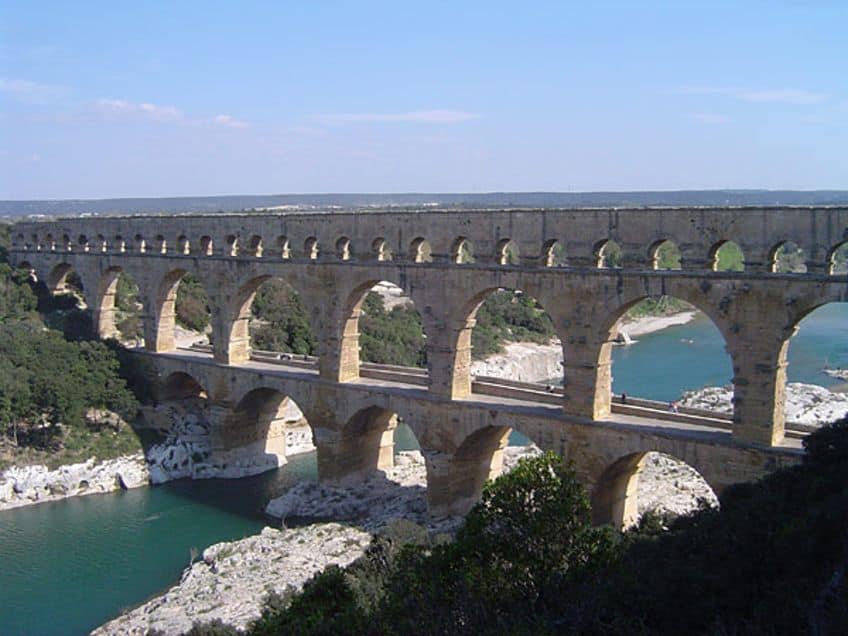
Aqua Anio Vetus (3rd Century CE) in Vicovaro, Rome, Italy
| Architect | Marcus Fulvius Flaccus (c. 3rd century) |
| Date | 3rd century CE |
| Length (kilometers) | 64 |
| Location | Vicovaro, Rome, Italy |
The Aqua Anio Vetus was built in the third century BCE to supply water to the city of Rome. The aqueduct was more than 64 kilometers long and used a combination of arches and tunnels to transfer water. The usage of the water channel, paved with hydraulic masonry and topped with massive stone slabs, characterizes the Aqua Anio Vetus.

The channel was also built with a series of sluices and weirs to control the water flow and prevent eddies from forming. It flowed down the valley from its source to Tivoli, where it joined the Anio and headed into the Alban Hills, at Gallicano, below Palestrina. It passed beneath the Via Latina around the seventh milestone and then turned in a northwesterly direction to reach Rome at the fourth milestone.
How Roman Aqueducts Functioned
So, we know that the aqueducts used gravity to move water along great distances, but how did they function overall? How was water sourced, transported, and distributed, for example? How were these long structures maintained over time?
Let’s find out more about how Roman aqueducts actually worked.
Sourcing of Water
How did the ancient Romans find the water sources used for their aqueducts? Was there a method for finding these water sources? There were general rules of thumb as well as long-standing Roman traditions on where to seek water. Vitruvius produced ten architectural books including one on finding water. Some of his advice is self-evident, such as looking for a lake or mist and inspecting the water quality. He also suggested meeting with the locals around a water source to observe what their skin complexions were like. If they were healthy-looking, it was a good indication that their water supply was clean and worth using.
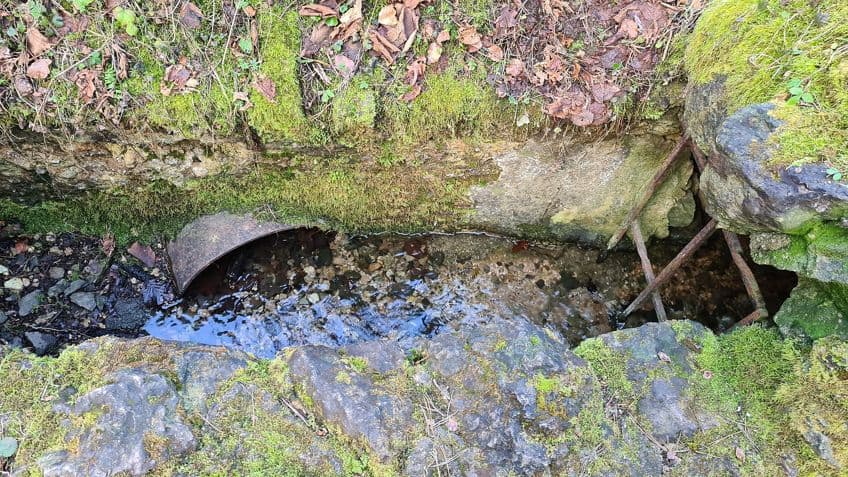
The Romans thoroughly examined the water source. Did it appear brackish? Lakes and streams could often prove to be problematic. Frontinus, who authored a treatise on the Roman aqueduct system around the year 100 CE, recounts how the water arrived in town extremely muddy after storms in the countryside. This murky water would suddenly appear from the fountains. They were sometimes able to clean up the water to some extent. They would even redirect it to industrial or irrigation purposes where purity was less critical.
The most desired water in Rome came from the springs. They were more difficult to locate since they were sometimes subterranean.
Certain methods were employed by the Romans to determine where to dig a well in order to connect to a spring. Finding spots of green grass in a dry season, for example, or the presence of a certain type of plant could also serve as clues. It was challenging since springs do not always bubble to the top. To start the aqueduct, they would dig down to the water table and construct a tunnel underground.
Transportation Through Tunnels
For security reasons, one of Rome’s early aqueducts was built fully underground. It was less susceptible to adversaries because it was underground. Building arches was like telling the adversary, “Here is our Roman aqueduct”. Tunnels also don’t interfere with surface activities like farming or transportation, which is a positive. Consider what today’s motorways can do to a community. Tunnels were also less susceptible to weather conditions, wind erosion, and earthquakes. That was no longer an issue as Rome expanded and its frontiers reached 1,000 miles away. At that point, they weren’t concerned about the enemy finding them anymore.
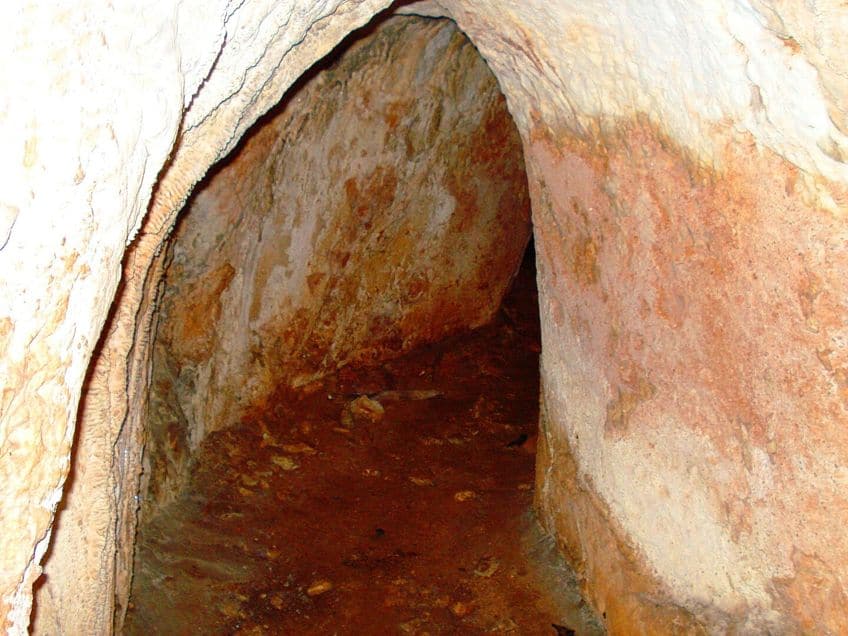
The Grand Arcades and Channels
The arcades are regarded as one of the Roman Empire’s hallmarks. The aqueducts were mostly gravity-fed. They needed to maintain the water at a set level since it was difficult to bring it back up. So, they had to keep the channel at a set height to maintain a constant gradient towards Rome and bring it in at a high enough level. When the canal reached a dip in the topography, they built an arcade to carry the water over it.
The long dramatic arches of Rome occurred around nine kilometers outside the town.
They were erected there because the terrain in Rome dipped before rising again to the hills. They would erect a wall if they had to construct an aqueduct just five feet high. However, they utilized the archway at any height above that. Arcades do not have the same impact on the landscape as walls. A five-mile-long wall disrupts surface transit and forms a water barrier.
Water Purification
Nowadays we use water treatment plants and chemicals to purify our water, but did the Romans have any water-cleaning mechanisms? Well, they didn’t utilize chemicals, but they did have other methods. They started with settling basins which were like a pool. The basins would delay the flow of water, and the contaminants, or load, as it’s known, dropped out of it as it slowed. Some of the impurities and sand would be removed as a result. Water can also be purified by aerating it. The water in the Roman aqueducts was exposed to air during its voyage, but we don’t know if the Romans were aware that this has a purifying effect.

One of the Roman aqueducts was designed with zigzags instead of a settling basin. Researchers believe that the zigzags helped the water to slow down, allowing the impurities to be unloaded. The Romans had to turn off the water on occasion. Someone would enter a tunnel from the surface through a well-hole. Small handholds would be cut into the shaft’s walls, which slaves used to descend to the water, where they would shovel away impurities, which were then transported to the surface in buckets.
Distribution
Roman Aqueduct mains were able to be tapped directly, but they were most commonly fed through public distribution terminals known as castellum aquae, which served as cisterns and settling tanks, as well as supplying numerous spurs and branches via ceramic or lead pipes. These pipes were manufactured in 25 specified sizes and equipped with bronze stopcocks. The flow from any pipe could be entirely or partially opened or shut, and its supply could be transferred to any other area of the system where demand for water was outstripping supply.
The free supply of water to public drinking fountains and basins was formally prioritized above the supply to public baths, where a fee was levied to every bather.
The latter were registered with the city, as was the bore of pipe leading from the public water supply to their land – the larger the pipe, the higher the associated fee. Some people were granted the ability to take excess water for free as a State honor or grant; pipe stamps reveal that over half of Rome’s water grants were awarded to elite, highly affluent senatorial class members.
Maintenance
These ancient Roman Aqueducts could often take years to build, making them expensive, especially if arches were also required. The aqueducts in Rome also needed to be maintained and safeguarded against damage. The Roman administration employed over 700 workers to maintain them at one point. Maintenance provisions were also built into the design. Underground parts of the aqueducts, for example, were made accessible through numerous shafts and manholes. Engineers were able to also temporarily redirect water away from a broken portion when extensive repairs were required.

During the Imperial period, the emperors were given lifelong responsibility for water supplies. Until Augustus established the post of water commissioner, the city of Rome did not have any permanent central authority to supervise the aqueducts; it was a high-rank, high-profile appointment. Frontinus, an individual who had already served as general, consul, and provincial governor, was appointed curator aquarum by Emperor Nerva in 97 CE.
The City of Rome had 460 aqueduct employees under the rule of Emperor Claudius, both slave and free, who were paid by a combination of Imperial generosity and water fees provided by private subscribers.
The curator aquarum exercised magisterial powers over the water supply, aided by a staff of public employees, architects, scribes, notaries, and heralds; when operating outside the city, he was also granted two lictors to reinforce his authority. Significant fines might be levied for even minor violations of aqueduct legislation, such as letting a tree harm the conduit and 100,000 sesterces for contaminating the water within the system or letting one’s slave do so.
The Significance of the Roman Aqueducts
The aqueducts in Rome would have a significant impact on the everyday lives of the city’s citizens. The availability of fresh running water opened all sorts of economic and social possibilities for the Romans. The Roman aqueducts also left behind a significant architectural legacy that would be emulated by subsequent cultures.

Economic Impact
The aqueducts in Rome enabled crop irrigation outside of the city, increasing agricultural output and supporting Rome’s burgeoning population. This resulted in a surplus of food, allowing Rome to become a significant hub of commerce and trade. With access to a steady water supply, Rome was able to establish water-dependent businesses like tanning, textile manufacturing, and milling. These types of industries were critical to the city’s economic development and success. The aqueducts facilitated the expansion of Rome’s urban infrastructure, including roads, public buildings, and bridges.
This infrastructure supported the city’s growing population while also facilitating trade and commerce, which also aided the economy’s growth.
Social Impact
The Roman aqueducts made it possible to build public fountains around the city, which became prominent social meeting spots. These fountains were not only water supplies, but also ornamental features in the city’s architecture. The aqueducts in Rome enabled the building of vast public baths, which also served as social gathering places. These baths were an important element of Roman society because they provided a place for people to mingle, exercise, and rest. The aqueducts aided in the spread of Roman influence and culture across the empire. Other cultures admired the aqueducts, which became icons of Roman architectural supremacy.

The Legacy of the Roman Aqueducts
The aqueducts needed significant engineering knowledge and skills, and the Romans were able to develop complex water management and distribution systems. The aqueducts are still a tribute to their engineering brilliance, inspiring architects and engineers today. The aqueducts were part of a broader network of public works projects conducted by the Roman government to better the lives of its residents.
This public works heritage continues to shape our current concepts about the role of government in delivering public services and maintaining infrastructure.
The ancient Roman engineers were water management pioneers, devising ways for catching, storing, and transporting water that is being utilized today. Their water management ideas have had a long-lasting influence on the development of urban areas and civilizations throughout our history. The aqueducts had a huge influence on Roman civilization, influencing everything from the city’s sanitation to the citizen’s social life. They are still prominent icons of Roman civilization, inspiring literature, art, and popular culture.

Those are all of our facts about Roman aqueducts that you would potentially find useful and interesting. These ancient Roman aqueducts were created so many centuries ago, yet some of them are still in use today! That just proves that the aqueducts in Rome really were engineering marvels that even continue to impress and inspire us today. Thanks to Roman aqueducts, the citizens of the city were able to always enjoy fresh running water, beautifying the city with incredible and stunning fountains, and allowing the Romans to live clean and sanitary lives, while making a living from water-heavy industries.
Frequently Asked Questions
What Is an Aqueduct?
An aqueduct is a structure designed by man to transfer water over a long distance, often from a freshwater source to a designated urban or agricultural area. Aqueducts are often made up of a network of water-transporting channels, bridges, and other support structures. An aqueduct’s function is to provide a consistent supply of water for irrigation, human consumption, and other purposes, and it has been employed by numerous civilizations throughout history to aid in the expansion and development of towns and civilizations.
What Were Aqueducts Used For?
Aqueducts were utilized to provide clean drinking and cooking water, which was critical for the health and sanitation of the public. Water from these aqueducts was also utilized to irrigate crops, which increased agricultural production and sustained the rising populations. The water was used to power mills that required a consistent supply of water. The water from the aqueducts was used to fill the public baths, which were seen as vital in ancient Rome. Aqueducts were also utilized to provide water for beautiful fountains and other aesthetic elements in public and private places.
How Do Aqueducts Work?
They use gravity to convey water across large distances from a source to a specific destination. The water is collected and diverted into an aqueduct system from a natural source, such as a river or spring. The system is made up of a network of channels, tunnels, and supporting structures that are made to convey water while preventing evaporation or leakage.
Justin van Huyssteen is a freelance writer, novelist, and academic originally from Cape Town, South Africa. At present, he has a bachelor’s degree in English and literary theory and an honor’s degree in literary theory. He is currently working towards his master’s degree in literary theory with a focus on animal studies, critical theory, and semiotics within literature. As a novelist and freelancer, he often writes under the pen name L.C. Lupus.
Justin’s preferred literary movements include modern and postmodern literature with literary fiction and genre fiction like sci-fi, post-apocalyptic, and horror being of particular interest. His academia extends to his interest in prose and narratology. He enjoys analyzing a variety of mediums through a literary lens, such as graphic novels, film, and video games.
Justin is working for artincontext.org as an author and content writer since 2022. He is responsible for all blog posts about architecture, literature and poetry.
Learn more about Justin van Huyssteen and the Art in Context Team.
Cite this Article
Justin, van Huyssteen, “Roman Aqueducts – The History of Ancient Roman Aqueducts.” Art in Context. June 19, 2023. URL: https://artincontext.org/roman-aqueducts/
van Huyssteen, J. (2023, 19 June). Roman Aqueducts – The History of Ancient Roman Aqueducts. Art in Context. https://artincontext.org/roman-aqueducts/
van Huyssteen, Justin. “Roman Aqueducts – The History of Ancient Roman Aqueducts.” Art in Context, June 19, 2023. https://artincontext.org/roman-aqueducts/.






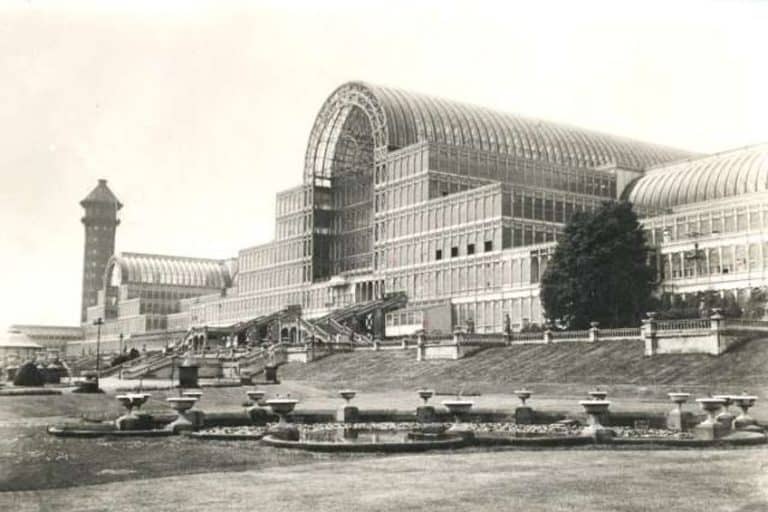


Hello Justin,
I love this Roman Aqueduct piece.
The Romans were among the greatest builders of all time as you know.
My point here is that I was in the Peace Corps in Tunisia from 1978-1980.
Most of the northern part of Tunisia’s water supply came down from the Atlas Mts.
through a Roman Aqueduct that I drank from every day! It’s mind boggling.
Of course the country is full of Roman ruins including Carthage, where I was involved
with a UNESCO archaeological exhibit by painting a 25″ mural at the Tunisian Museum of History.
The exhibition went on to Paris from Carthage